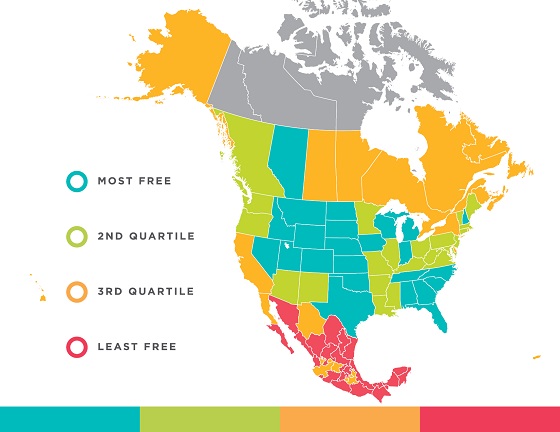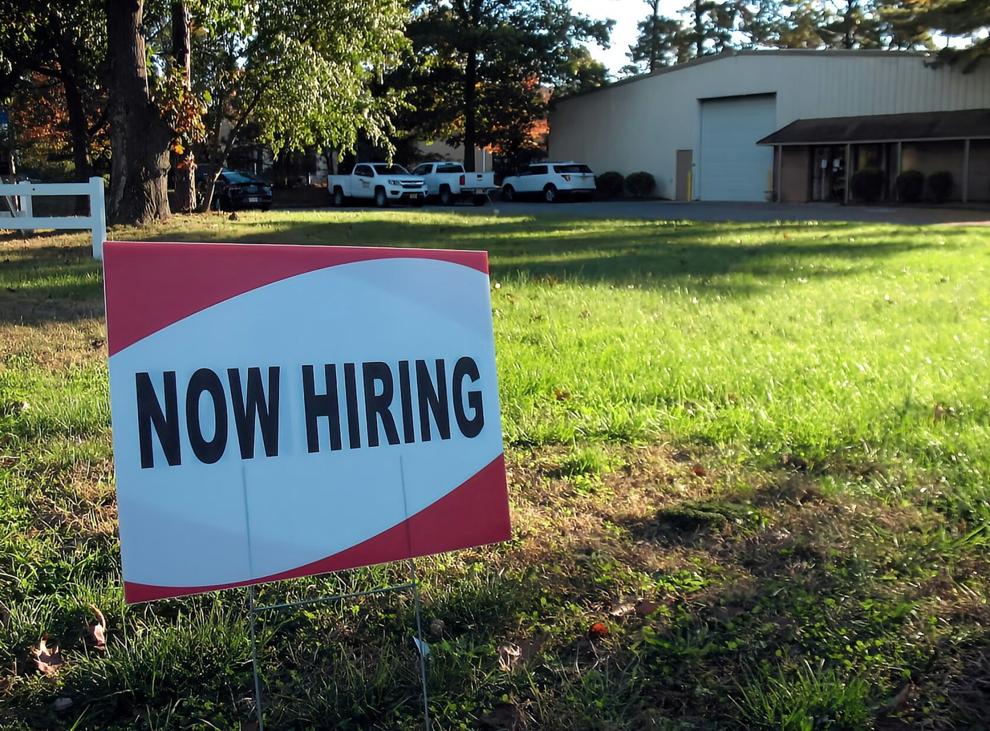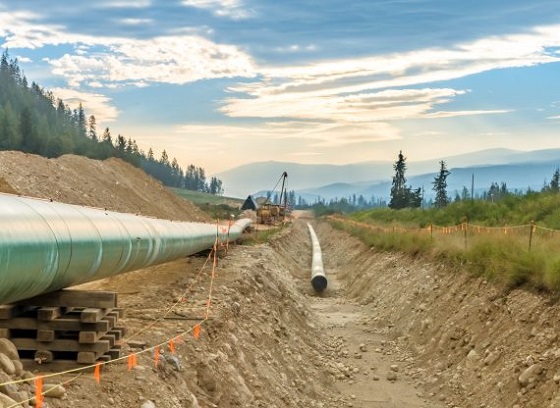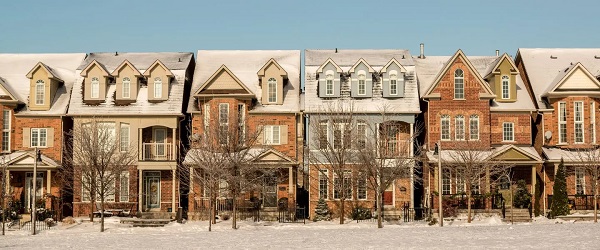Business
Alberta freest Canadian province, ranks 12th in North American; other provinces rank near bottom

From the Fraser Institute
By: Dean Stansel, José Torra, Matthew D. Mitchell and Ángel Carrión-Tavárez
Alberta is, once again, the Canadian province with the highest level of economic freedom, while most other provinces rank in the bottom half in the annual Economic Freedom of North America report, published today by the Fraser Institute, an independent, non-partisan, public policy think-tank.
Individuals have more economic freedom when they are allowed to make more of their own economic decisions such as what to buy, where to work and how to start and run a business. And research shows that economic freedom is fundamental to prosperity.
The report ranks the provinces and states individually for each country (Canada, the U.S. and Mexico). In addition, there is a fourth measure comparing and ranking all states and provinces, across all three countries. All of the rankings measure government spending, taxation, regulations and labour market restrictions using data from 2022 (the latest year of available comparable data).
“Higher taxes, higher levels of government spending and overly burdensome regulations continue to depress economic freedom across much of Canada, which makes it harder for individuals and businesses to thrive and create jobs,” said Matthew Mitchell, a senior fellow at the Fraser Institute and co-author of this year’s report.
In the ranking covering all three countries, which includes both federal and provincial government policies, Alberta is once again the highest-ranking Canadian province. It tied four U.S. states at 12th, having improved its ranking from 41st last year.
The next freest province is British Columbia, which ranks 43rd out of 93, followed by Ontario (47th), Saskatchewan (50th), Manitoba (53rd) and Quebec (54th).
The four Atlantic provinces— New Brunswick (57th), Prince Edward Island (58th), Nova Scotia (59th) and Newfoundland and Labrador (60th)—have the lowest levels of economic freedom among all provinces and U.S. states, only outranking the Mexican states and Puerto Rico. New Hampshire, once again, earned the overall top spot amongst all provinces and states in the rankings this year.
“The link between economic freedom and prosperity is clear: people who live in provinces or states that have comparatively lower taxation, lower government, sound regulatory regimes and more flexible labor markets tend, on average, to live happier, healthier and wealthier lives,” Mitchell said.
For instance, according to the latest report, total income in the freest jurisdictions grew 29 per cent after adjusting for inflation over the last decade, while in the least-free jurisdictions, total inflation adjusted income fell 13 per cent.
The Economic Freedom of North America report (co-authored by Dean Stansel, José Torra and Ángel Carrión-Tavárez) is an offshoot of the Fraser Institute’s Economic Freedom of the World index, the result of more than a quarter century of work by more than 60 scholars including three Nobel laureates.
Detailed tables for each country and subnational jurisdiction can be found at www.freetheworld.org.
Economic Freedom of North America 2024
- The indices in the Economic Freedom of North America 2024 measure the degree to which governments in North America permit their citizens to make their own economic choices.
- They include data from the 10 Canadian provinces, 50 US states, 32 Mexican states, and the US territory of Puerto Rico.
- In the all-government index—which takes account of federal as well as state/provincial policies—the most economically-free jurisdiction in North America is New Hampshire, followed by Idaho, Oklahoma and South Carolina tied for third, and Florida and Indiana tied for fifth.
- The lowest-ranking jurisdictions are all Mexican states. In last place is Ciudad de México. Above that is Colima, Campeche, Tamaulipas, and Zacatecas.
- Alberta is the highest-ranking Canadian province, tied for 12th place with Tennessee, South Dakota, Colorado, and Texas. The next-highest Canadian province is British Columbia, which is tied with Massachusetts, Minnesota, and New Mexico for 43rd.
- Average economic freedom across all 93 jurisdictions has fallen every year since 2017 and is now slightly above its all-time low.
- Incomes in the freest top 25 percent of North American jurisdictions were 21 times higher than in the least-free.
- From 2013 to 2022 the population of the freest US states grew 10 times faster and total employment grew three times faster than in the least-free states.
Business
Socialism vs. Capitalism

People criticize capitalism. A recent Axios-Generation poll says, “College students prefer socialism to capitalism.”
Why?
Because they believe absurd myths. Like the claim that the Soviet Union “wasn’t real socialism.”
Socialism guru Noam Chomsky tells students that. He says the Soviet Union “was about as remote from socialism as you could imagine.”
Give me a break.
The Soviets made private business illegal.
If that’s not socialism, I’m not sure what is.
“Socialism means abolishing private property and … replacing it with some form of collective ownership,” explains economist Ben Powell. “The Soviet Union had an abundance of that.”
Socialism always fails. Look at Venezuela, the richest country in Latin America about 40 years ago. Now people there face food shortages, poverty, misery and election outcomes the regime ignores.
But Al Jazeera claims Venezuela’s failure has “little to do with socialism, and a lot to do with poor governance … economic policies have failed to adjust to reality.”
“That’s the nature of socialism!” exclaims Powell. “Economic policies fail to adjust to reality. Economic reality evolves every day. Millions of decentralized entrepreneurs and consumers make fine tuning adjustments.”
Political leaders can’t keep up with that.
Still, pundits and politicians tell people, socialism does work — in Scandinavia.
“Mad Money’s Jim Cramer calls Norway “as socialist as they come!”
This too is nonsense.
“Sweden isn’t socialist,” says Powell. “Volvo is a private company. Restaurants, hotels, they’re privately owned.”
Norway, Denmark and Sweden are all free market economies.
Denmark’s former prime minister was so annoyed with economically ignorant Americans like Bernie Sanders calling Scandanavia “socialist,” he came to America to tell Harvard students that his country “is far from a socialist planned economy. Denmark is a market economy.”
Powell says young people “hear the preaching of socialism, about equality, but they don’t look on what it actually delivers: poverty, starvation, early death.”
For thousands of years, the world had almost no wealth creation. Then, some countries tried capitalism. That changed everything.
“In the last 20 years, we’ve seen more humans escape extreme poverty than any other time in human history, and that’s because of markets,” says Powell.
Capitalism makes poor people richer.
Former Rep. Jamaal Bowman (D-N.Y.) calls capitalism “slavery by another name.”
Rep. Alexandria Ocasio-Cortez (D-N.Y.) claims, “No one ever makes a billion dollars. You take a billion dollars.”
That’s another myth.
People think there’s a fixed amount of money. So when someone gets rich, others lose.
But it’s not true. In a free market, the only way entrepreneurs can get rich is by creating new wealth.
Yes, Steve Jobs pocketed billions, but by creating Apple, he gave the rest of us even more. He invented technology that makes all of us better off.
“I hope that we get 100 new super billionaires,” says economist Dan Mitchell, “because that means 100 new people figured out ways to make the rest of our lives better off.”
Former Labor Secretary Robert Reich advocates the opposite: “Let’s abolish billionaires,” he says.
He misses the most important fact about capitalism: it’s voluntary.
“I’m not giving Jeff Bezos any money unless he’s selling me something that I value more than that money,” says Mitchell.
It’s why under capitalism, the poor and middle class get richer, too.
“The economic pie grows,” says Mitchell. “We are much richer than our grandparents.”
When the media say the “middle class is in decline,” they’re technically right, but they don’t understand why it’s shrinking.
“It’s shrinking because more and more people are moving into upper income quintiles,” says Mitchell. “The rich get richer in a capitalist society. But guess what? The rest of us get richer as well.”
I cover more myths about socialism and capitalism in my new video.
Business
Residents in economically free states reap the rewards

From the Fraser Institute
A report published by the Fraser Institute reaffirms just how much more economically free some states are compared with others. These are places where citizens are allowed to make more of their economic choices. Their taxes are lighter, and their regulatory burdens are easier. The benefits for workers, consumers and businesses have been clear for a long time.
There’s another group of states to watch: “movers” that have become much freer in recent decades. These are states that may not be the freest, but they have been cutting taxes and red tape enough to make a big difference.
How do they fare?
I recently explored this question using 22 years of data from the same Economic Freedom of North America index. The index uses 10 variables encompassing government spending, taxation and labour regulation to assess the degree of economic freedom in each of the 50 states.
Some states, such as New Hampshire, have long topped the list. It’s been in the top five for three decades. With little room to grow, the Granite State’s level of economic freedom hasn’t budged much lately. Others, such as Alaska, have significantly improved economic freedom over the last two decades. Because it started so low, it remains relatively unfree at 43rd out of 50.
Three states—North Carolina, North Dakota and Idaho—have managed to markedly increase and rank highly on economic freedom.
In 2000, North Carolina was the 19th most economically free state in the union. Though its labour market was relatively unhindered by the state’s government, its top marginal income tax rate was America’s ninth-highest, and it spent more money than most states.
From 2013 to 2022, North Carolina reduced its top marginal income tax rate from 7.75 per cent to 4.99 per cent, reduced government employment and allowed the minimum wage to fall relative to per-capita income. By 2022, it had the second-freest labour market in the country and was ninth in overall economic freedom.
North Dakota took a similar path, reducing its 5.54 per cent top income tax rate to 2.9 per cent, scaling back government employment, and lowering its minimum wage to better reflect local incomes. It went from the 27th most economically free state in the union in 2000 to the 10th freest by 2022.
Idaho saw the most significant improvement. The Gem State has steadily improved spending, taxing and labour market freedom, allowing it to rise from the 28th most economically free state in 2000 to the eighth freest in 2022.
We can contrast these three states with a group that has achieved equal and opposite distinction: California, Delaware, New Jersey and Maryland have managed to decrease economic freedom and end up among the least free overall.
What was the result?
The economies of the three liberating states have enjoyed almost twice as much economic growth. Controlling for inflation, North Carolina, North Dakota and Idaho grew an average of 41 per cent since 2010. The four repressors grew by just 24 per cent.
Among liberators, statewide personal income grew 47 per cent from 2010 to 2022. Among repressors, it grew just 26 per cent.
In fact, when it comes to income growth per person, increases in economic freedom seem to matter even more than a state’s overall, long-term level of freedom. Meanwhile, when it comes to population growth, placing highly over longer periods of time matters more.
The liberators are not unique. There’s now a large body of international evidence documenting the freedom-prosperity connection. At the state level, high and growing levels of economic freedom go hand-in-hand with higher levels of income, entrepreneurship, in-migration and income mobility. In economically free states, incomes tend to grow faster at the top and bottom of the income ladder.
These states suffer less poverty, homelessness and food insecurity and may even have marginally happier, more philanthropic and more tolerant populations.
In short, liberation works. Repression doesn’t.
-

 armed forces1 day ago
armed forces1 day agoOttawa’s Newly Released Defence Plan Crosses a Dangerous Line
-

 espionage1 day ago
espionage1 day agoCarney Floor Crossing Raises Counterintelligence Questions aimed at China, Former Senior Mountie Argues
-

 Health1 day ago
Health1 day agoAll 12 Vaccinated vs. Unvaccinated Studies Found the Same Thing: Unvaccinated Children Are Far Healthier
-

 Energy1 day ago
Energy1 day ago75 per cent of Canadians support the construction of new pipelines to the East Coast and British Columbia
-

 Opinion1 day ago
Opinion1 day agoPope Leo XIV’s Christmas night homily
-

 armed forces1 day ago
armed forces1 day agoRemembering Afghanistan and the sacrifices of our military families
-

 Fraser Institute15 hours ago
Fraser Institute15 hours agoCarney government sowing seeds for corruption in Ottawa
-

 Fraser Institute1 day ago
Fraser Institute1 day agoHow to talk about housing at the holiday dinner table






